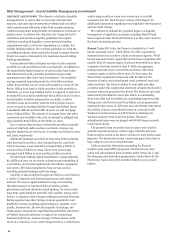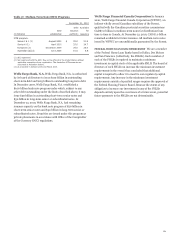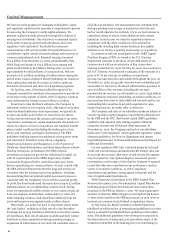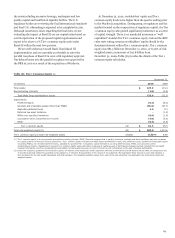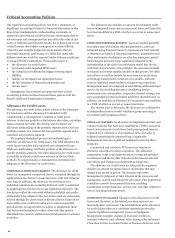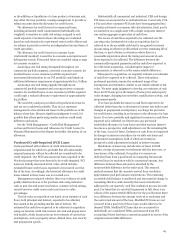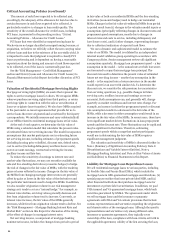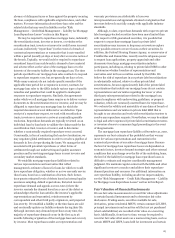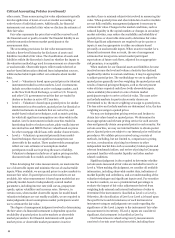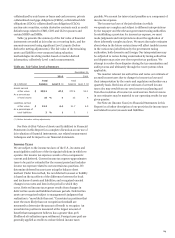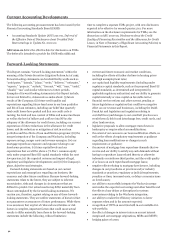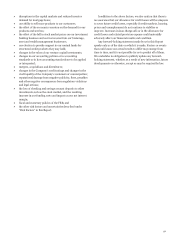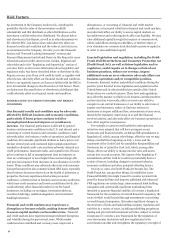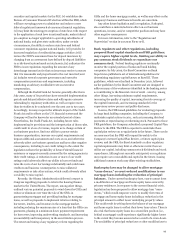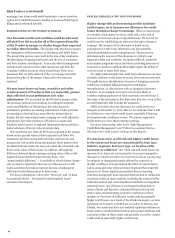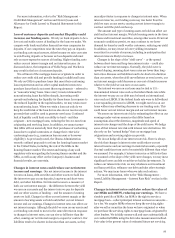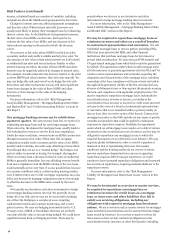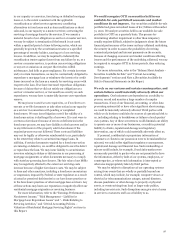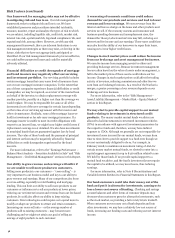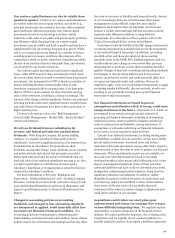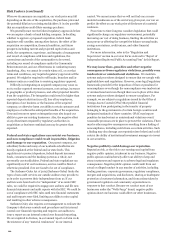Wells Fargo 2010 Annual Report Download - page 92
Download and view the complete annual report
Please find page 92 of the 2010 Wells Fargo annual report below. You can navigate through the pages in the report by either clicking on the pages listed below, or by using the keyword search tool below to find specific information within the annual report.
The following accounting pronouncement has been issued by the
Financial Accounting Standards Board (FASB):
Current Accounting Developments
• Accounting Standards Update (ASU) 2011-01, Deferral of
the Effective Date of Disclosures about Troubled Debt
Restructurings in Update No. 2010-20.
ASU 2011-01 defers the effective date for disclosures on TDRs.
The deferral is intended to provide the FASB with additional
time to complete a separate TDRs project, with new disclosures
expected to be effective for second quarter 2011. For more
information on the disclosure requirements for TDRs, see the
discussion on ASU 2010-20, Disclosures about the Credit
Quality of Financing Receivables and the Allowance for Credit
Losses, in Note 1 (Summary of Significant Accounting Policies) to
Financial Statements in this Report.
This Report contains “forward-looking statements” within the
meaning of the Private Securities Litigation Reform Act of 1995.
Forward-looking statements can be identified by words such as
“anticipates,” “intends,” “plans,” “seeks,” “believes,” “estimates,”
“expects,” “projects,” “outlook,” “forecast,” “will,” “may,” “could,”
“should,” “can” and similar references to future periods.
Examples of forward-looking statements in this Report include,
but are not limited to, statements we make about: (i) future
results of the Company; (ii) future credit quality and
expectations regarding future loan losses in our loan portfolios
and life-of-loan estimates, including our belief that quarterly
total credit losses have peaked and that our credit cycle is
turning; the level and loss content of NPAs and nonaccrual loans
as well as the level of inflows and outflows into NPAs; the
adequacy of the allowance for credit losses, including our current
expectation of future reductions in the allowance for credit
losses; and the reduction or mitigation of risk in our loan
portfolios and the effects of loan modification programs; (iii) the
merger integration of the Company and Wachovia, including
expense savings, merger costs and revenue synergies; (iv) our
mortgage repurchase exposure and exposure relating to our
foreclosure practices; (v) future capital levels and our
expectations that we will be above a 7% Tier 1 common equity
ratio under proposed Basel III capital standards within the next
few quarters; (vi) the expected outcome and impact of legal,
regulatory and legislative developments; and (vii) the Company’s
plans, objectives and strategies.
Forward-Looking Statements
Forward-looking statements are based on our current
expectations and assumptions regarding our business, the
economy and other future conditions. Because forward-looking
statements relate to the future, they are subject to inherent
uncertainties, risks and changes in circumstances that are
difficult to predict. Our actual results may differ materially from
those contemplated by the forward-looking statements. We
caution you, therefore, against relying on any of these forward-
looking statements. They are neither statements of historical fact
nor guarantees or assurances of future performance. While there
is no assurance that any list of risks and uncertainties or risk
factors is complete, important factors that could cause actual
results to differ materially from those in the forward-looking
statements include the following, without limitation:
• current and future economic and market conditions,
including the effects of further declines in housing prices
and high unemployment rates;
• our capital and liquidity requirements (including under
regulatory capital standards, such as the proposed Basel III
capital standards, as determined and interpreted by
applicable regulatory authorities) and our ability to generate
capital internally or raise capital on favorable terms;
• financial services reform and other current, pending or
future legislation or regulation that could have a negative
effect on our revenue and businesses, including the Dodd-
Frank Act and legislation and regulation relating to
overdraft fees (and changes to our overdraft practices as a
result thereof), debit card interchange fees, credit cards, and
other bank services;
• legislative proposals to allow mortgage cram-downs in
bankruptcy or require other loan modifications;
• the extent of our success in our loan modification efforts, as
well as the effects of regulatory requirements or guidance
regarding loan modifications or changes in such
requirements or guidance;
• the amount of mortgage loan repurchase demands that we
receive and our ability to satisfy any such demands without
having to repurchase loans related thereto or otherwise
indemnify or reimburse third parties, and the credit quality
of or losses on such repurchased mortgage loans;
• negative effects relating to mortgage foreclosures, including
changes in our procedures or practices and/or industry
standards or practices, regulatory or judicial requirements,
penalties or fines, increased costs, or delays or moratoriums
on foreclosures;
• our ability to successfully integrate the Wachovia merger
and realize the expected cost savings and other benefits and
the effects of any delays or disruptions in systems
conversions relating to the Wachovia integration;
• our ability to realize the efficiency initiatives to lower
expenses when and in the amount expected;
• recognition of OTTI on securities held in our available-for-
sale portfolio;
• the effect of changes in interest rates on our net interest
margin and our mortgage originations, MSRs and MHFS;
• hedging gains or losses;
90


